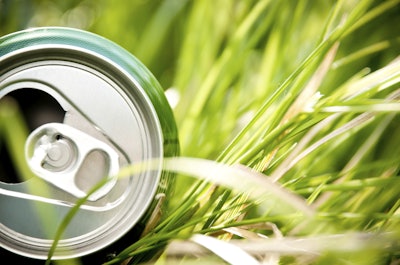
Aluminum cans are the most recycled and highest value beverage container on the market today, according to a new report released by The Aluminum Association and the Can Manufacturers Institute (CMI). The aluminum can has the highest recycling rate of any beverage container and contains 70% recycled content on average—more than three times that of glass or PET bottles. The study also found that aluminum-can recycled material is worth nearly 300% more per ton than plastic or glass.
“This new report confirms that aluminum cans are recycled by U.S. consumers at rates more than 20 points higher than that of other beverage containers, making them the sustainable package of choice,” says Heidi Brock, President and CEO of The Aluminum Association.“Cans are recycled at the highest rates, and drive recycling programs across the country because of the high value of aluminum compared to other packaging materials.”
According to the association, the new report, “The Aluminum Can Advantage: Key Sustainability Indicators 2015,” provides a holistic approach to sustainability tracking of the aluminum can and will be a useful guide for consumers, non-governmental organizations, policymakers, and other stakeholders across the value chain. The Aluminum Association plans to release a new “key performance indicator” report each year with updated data to track progress over time.
Key findings in the report include:
- The aluminum industry recycling rate, which measures the amount of used aluminum can scrap, including imported and exported cans that get recycled as a percentage of U.S. shipments, was essentially flat in 2014 at 66.5%.This reflects more than 59 million cans recycled and marks the fourth year in a row the rate has held near historically high levels.
- The consumer recycling rate for aluminum cans, which measures domestic consumer recycling behavior, was up nearly 2 points to 56.7% in 2014, the highest rate reported since 1997 and a more than 12-point improvement since earlier in the decade. This compares to consumer recycling rates in the low-to-mid 30s for glass and plastic bottles.
- Aluminum cans contain more than three times the recycled content of glass or plastic, with 70% recycled content on average. This compares to Environmental Protection Agency (EPA)-estimated 23% recycled content for glass and 3% recycled content for plastic bottles.
- Aluminum can scrap is worth $1,491 per ton versus $385 per ton for plastic and $0 per ton for glass. The high value of material for aluminum helps make municipal recycling programs financially viable and effectively subsidizes the recycling of less valuable materials in the bin.
- Additionally, aluminum cans have reduced their weight by 38% since 1972, down to 12.99 g on average. Aluminum cans are more than 15-times lighter than standard 12-oz glass bottles, allowing brands to package and transport more beverages using less material.
In 2008, The Aluminum Association announced a targeted industry recycling goal of 75% by 2015. At the time of the announcement, the industry rate was 54.1% following a decade of declining recycling.The rising rate is due to the combination of an increase in domestic consumer recycling and of increased industry recycling of imported can scrap. Domestic consumer recycling is also up nearly 9 points since 2008 to 56.7%, jumping nearly two percentage points last year alone.
“We’re proud of the progress that has been made in strengthening our position as the most recycled and highest recycled content container on the market today,” says Heidi Brock. “Our ultimate goal is to do even better—collect as many cans as possible and get them back into the recycling loop. Doing that is an economic and environmental win for everyone.”
Reports The Aluminum Association, each year in the U.S. nearly 40 billion cans—$800 million worth of aluminum—end up landfills. The energy saved by recycling 100% of aluminum cans in the U.S. could power 4 million homes for a full year. Making a can from recycled aluminum saves 92% of the energy required to make a new can.





















